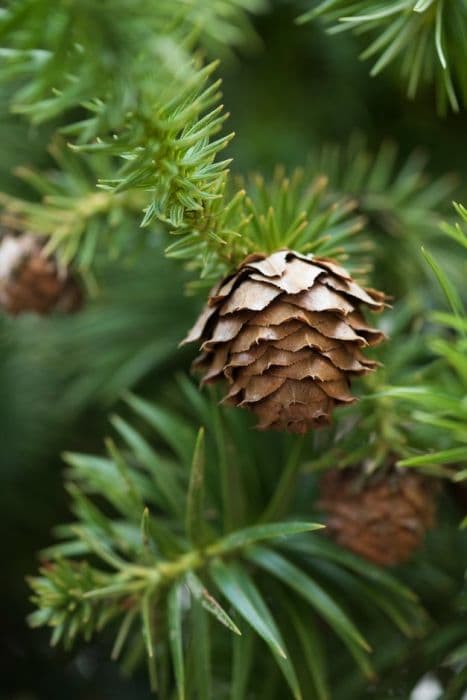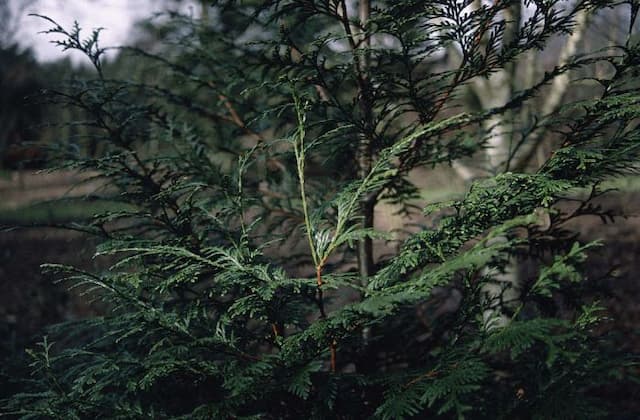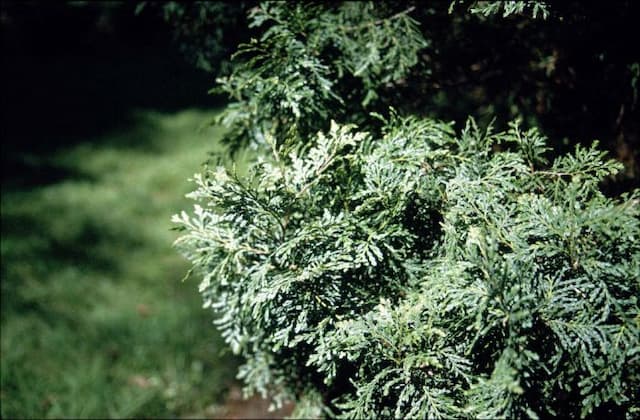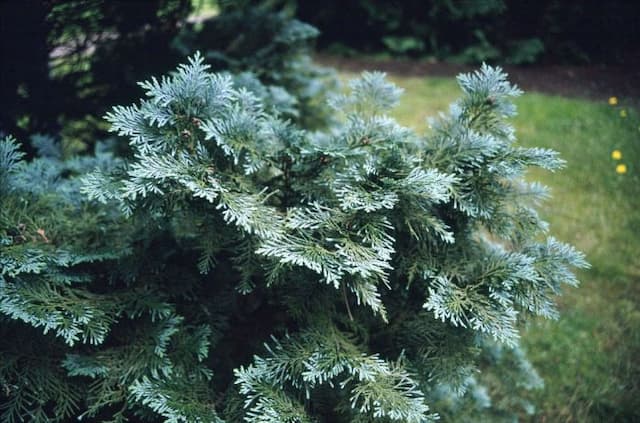Chinese Juniper Juniperus chinensis 'Plumosa Aurea'











ABOUT
The Juniperus chinensis 'Plumosa Aurea', commonly known as the Chinese Juniper 'Plumosa Aurea', is a visually striking plant with a dense, ornamental foliage. This evergreen conifer showcases a rich tapestry of feathery, soft needles that are artfully arranged on gracefully arching branches. Its needles exhibit a delightful combination of colors, primarily a golden-yellow hue, especially at the tips, which then transitions into a deeper green tone towards the base, creating a vibrant contrast that adds depth to its appearance. The Chinese Juniper 'Plumosa Aurea' is a slow-growing plant that maintains a bushy, somewhat rounded overall shape, lending it well to landscaping where it can serve as an eye-catching focal point or as part of a mixed border for accentuating contrasts. The intertwining branches produce an intricate, lace-like texture that can add visual interest year-round. The needles themselves are relatively soft to the touch compared to other junipers, which often have sharper foliage. Characteristic of most junipers, the Chinese Juniper 'Plumosa Aurea' may produce small, berry-like cones that add another layer of ornamental appeal. These berries start green and mature into a more bluish-black shade. However, they are not the main feature of the plant and may not be present or noticeable throughout the year. Overall, with its lush, golden to green gradient foliage and elegant, mounded growth habit, the Chinese Juniper 'Plumosa Aurea' is a charming and vibrant addition to any garden setting, bringing color and texture to the landscape without requiring large spaces to develop its beauty.
About this plant
 Names
NamesFamily
Cupressaceae
Synonyms
Chinese Juniper, Gold Coast Juniper, Old Gold Juniper, Aurea Plumosa Juniper
Common names
Juniperus chinensis 'Plumosa Aurea'.
 Toxicity
ToxicityTo humans
The Chinese juniper is not generally considered highly toxic to humans. However, ingesting any part of the plant can cause mild stomach upset if consumed in large quantities. There are no severe symptoms of poisoning expected from casual contact or small accidental ingestions.
To pets
The Chinese juniper is also not generally considered highly toxic to pets. However, similar to humans, if pets ingest large quantities of the plant, they may experience mild gastrointestinal upset, such as vomiting or diarrhea. It is not expected to cause severe poisoning or long-term health consequences in animals when ingested in typical amounts that might occur during incidental chewing or consumption.
 Characteristics
CharacteristicsLife cycle
Perennials
Foliage type
Evergreen
Color of leaves
Golden
Height
4-6 feet (1.2-1.8 meters)
Spread
6-8 feet (1.8-2.4 meters)
Plant type
Shrub
Hardiness zones
4-9
Native area
China
Benefits
 General Benefits
General Benefits- Aesthetic Appeal: Juniperus chinensis 'Plumosa Aurea', commonly known as Golden Chinese Juniper, has a distinctive yellow foliage that adds color and ornamental value to gardens and landscapes.
- Low Maintenance: Golden Chinese Juniper is a hardy plant that requires minimal care once established, making it ideal for busy gardeners and landscapes with limited maintenance resources.
- Drought Tolerance: This plant is highly tolerant of dry conditions and can thrive in areas where water conservation is a priority.
- Erosion Control: The dense growth habit and extensive root system of Golden Chinese Juniper help to stabilize soil and prevent erosion, particularly on slopes and banks.
- Wildlife Habitat: The thick foliage provides shelter and nesting sites for birds and other small animals. Additionally, its berries can serve as a food source for wildlife.
- Privacy and Screening: Due to its dense growth, Golden Chinese Juniper can be used to create natural privacy screens or hedges, blocking unwanted views and reducing noise pollution.
- Versatility: It can be used in a variety of landscaping designs including formal gardens, rockeries, and as foundation plantings, thanks to its adaptability to pruning and shaping.
- Soil Improvement: Juniperus chinensis 'Plumosa Aurea' can help improve soil quality over time by adding organic matter as needles and small branches fall and decompose.
- Coastal Tolerance: This juniper variety can tolerate salt spray and is suitable for planting in coastal areas.
- Windbreak: It can act as a windbreak when planted in groups, protecting gardens and properties from strong winds.
- Winter Interest: The evergreen nature of the Golden Chinese Juniper provides year-round greenery, even in the coldest months, offering visual interest in winter landscapes.
 Medical Properties
Medical PropertiesThis plant is not used for medical purposes.
 Air-purifying Qualities
Air-purifying QualitiesThis plant is not specifically known for air purifying qualities.
 Other Uses
Other Uses- Woodworking: The wood of Juniperus chinensis can be used for creating small wooden objects such as boxes or decorative items due to its fine grain and pleasing aroma.
- Garden Sculpture: The dense foliage and unique color of Juniperus chinensis 'Plumosa Aurea' make it an excellent candidate for topiary or garden sculptures.
- Erosion Control: This plant's extensive root system makes it useful for stabilizing slopes and preventing soil erosion in landscaping.
- Privacy Screen: When planted in rows or clusters, Juniperus chinensis 'Plumosa Aurea' can function as a living privacy screen due to its thick foliage.
- Windbreak: Its resistance to wind makes it suitable for planting as a protective barrier against strong winds in exposed areas.
- Fragrance Sachets: Dried foliage of Juniperus chinensis 'Plumosa Aurea' can be used in sachets to provide a pleasant scent to closets and drawers.
- Traditional Crafts: The branches and foliage can be used in the art of bonsai to create miniature landscapes or as components in wreaths and natural art pieces.
- Wildlife Habitat: The dense growth habit provides shelter and nesting sites for birds.
- Garden Border: Its compact growth habit allows it to serve as a natural border or edging plant in garden beds and pathways.
- Theme Gardening: Juniperus chinensis 'Plumosa Aurea' can be included in Japanese-themed gardens due to its oriental appearance and origin.
Interesting Facts
 Feng Shui
Feng ShuiThe Chinese Juniper is not used in Feng Shui practice.
 Zodiac Sign Compitability
Zodiac Sign CompitabilityThe Chinese Juniper is not used in astrology practice.
 Plant Symbolism
Plant Symbolism- Protection: Junipers are often associated with protection due to their enduring and hardy nature, capable of withstanding harsh conditions.
- Purity: Given their clean, sharp fragrance, junipers have historically been used for cleansing and purification rituals.
- Healing: With a history of medicinal use, juniper plants are symbolically linked to healing and the treatment of various ailments.
- Longevity: The long lifespan of juniper plants makes them a symbol of longevity and enduring life.
 Water
WaterThe Chinese Juniper 'Plumosa Aurea' prefers soil that is moist but well-drained, requiring regular watering to maintain this balance. During the first growing season, it is critical to water the plant deeply once a week, supplying about 1 to 1.5 gallons per watering to establish an extensive root system. After establishment, reduce the frequency to every two to three weeks, depending on the rainfall and weather conditions. In periods of drought or extreme heat, additional watering may be necessary, but always check the soil moisture before watering to avoid over-saturation.
 Light
LightThe Chinese Juniper 'Plumosa Aurea' thrives best in full sun to partial shade, requiring at least six hours of direct sunlight daily. A spot that provides morning sun and some afternoon shade is ideal, especially in regions with intense summer heat. This type of light exposure ensures bright foliage color and healthy growth.
 Temperature
TemperatureThe Chinese Juniper 'Plumosa Aurea' can withstand a wide temperature range, ideally growing in the comfort zone between 30°F and 70°F. It can survive minimum winter temperatures down to -10°F and is generally heat tolerant, coping with highs up to 90°F. However, protecting the plant from harsh winter winds and extreme summer heat can prevent damage.
 Pruning
PruningPrune the Chinese Juniper 'Plumosa Aurea' to maintain its shape and remove any dead or diseased branches, promoting healthy growth and improving air circulation. The best time for pruning is in late winter or early spring before new growth begins. It's not necessary to prune every year unless shaping is required or to remove the occasional deadwood.
 Cleaning
CleaningNot needed
 Soil
SoilThe best soil mix for Chinese Juniper 'Plumosa Aurea' is well-draining, slightly acidic to neutral soil with a pH of 5.5 to 7.5. A mix containing equal parts of peat, sand, and loam is ideal. Ensuring good drainage is essential, as the plant does not tolerate water-logged soil.
 Repotting
RepottingChinese Juniper 'Plumosa Aurea' should be repotted every two to three years. It's important to do it in spring before new growth starts, using a well-draining soil mix to prevent root rot.
 Humidity & Misting
Humidity & MistingChinese Juniper 'Plumosa Aurea' tolerates a wide range of humidity levels but prefers low to moderate humidity. It is well-suited to the typical outdoor humidity and does not require additional humidity indoors.
 Suitable locations
Suitable locationsIndoor
Place near bright window, avoid heat sources, well-draining soil.
Outdoor
Full sun, well-drained soil, protect from strong winds.
Hardiness zone
4-9 USDA
 Life cycle
Life cycleThe life of the 'Plumosa Aurea' Chinese Juniper begins with seed germination, a process facilitated by cold stratification which breaks the seed's dormancy. Upon germination, the seedling starts to grow, developing a root system and foliage over the first few years. As the plant matures, it enters a period of vegetative growth, with its foliage developing the characteristic golden tips of 'Plumosa Aurea' and the plant increasing in size and girth. This juniper will then reach reproductive maturity, where it starts to produce cones, with male cones releasing pollen and female cones developing seeds after pollination. The seeds are then dispersed, often by birds or wind, to start a new generation. Throughout its life, which can span several decades, the Chinese Juniper will undergo seasonal growth cycles, with periods of active growth in the spring and summer and dormancy during the winter.
 Propogation
PropogationPropogation time
Spring-Early Summer
The most popular method of propagating Juniperus chinensis 'Plumosa Aurea', commonly known as the Chinese juniper, is by cutting. The best time to take cuttings is during the summer months when the plant is actively growing. Choose healthy, semi-hardwood sections from the current year's growth, typically 4-6 inches (approximately 10-15 centimeters) long. Strip the lower foliage to expose a clean stem, and dip the cut end into a rooting hormone to encourage growth. The cutting should then be planted in a well-draining soil mix and kept moist but not waterlogged. Place the pot in a warm area with indirect sunlight to avoid scorching the plant. Rooting generally takes several weeks, after which the new Chinese juniper can be further cared for or transplanted as desired.









